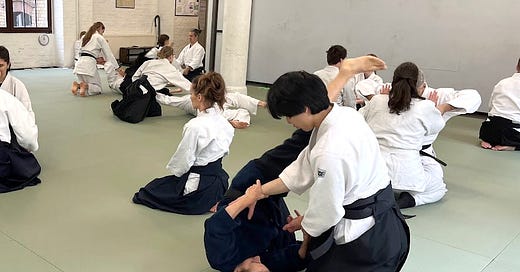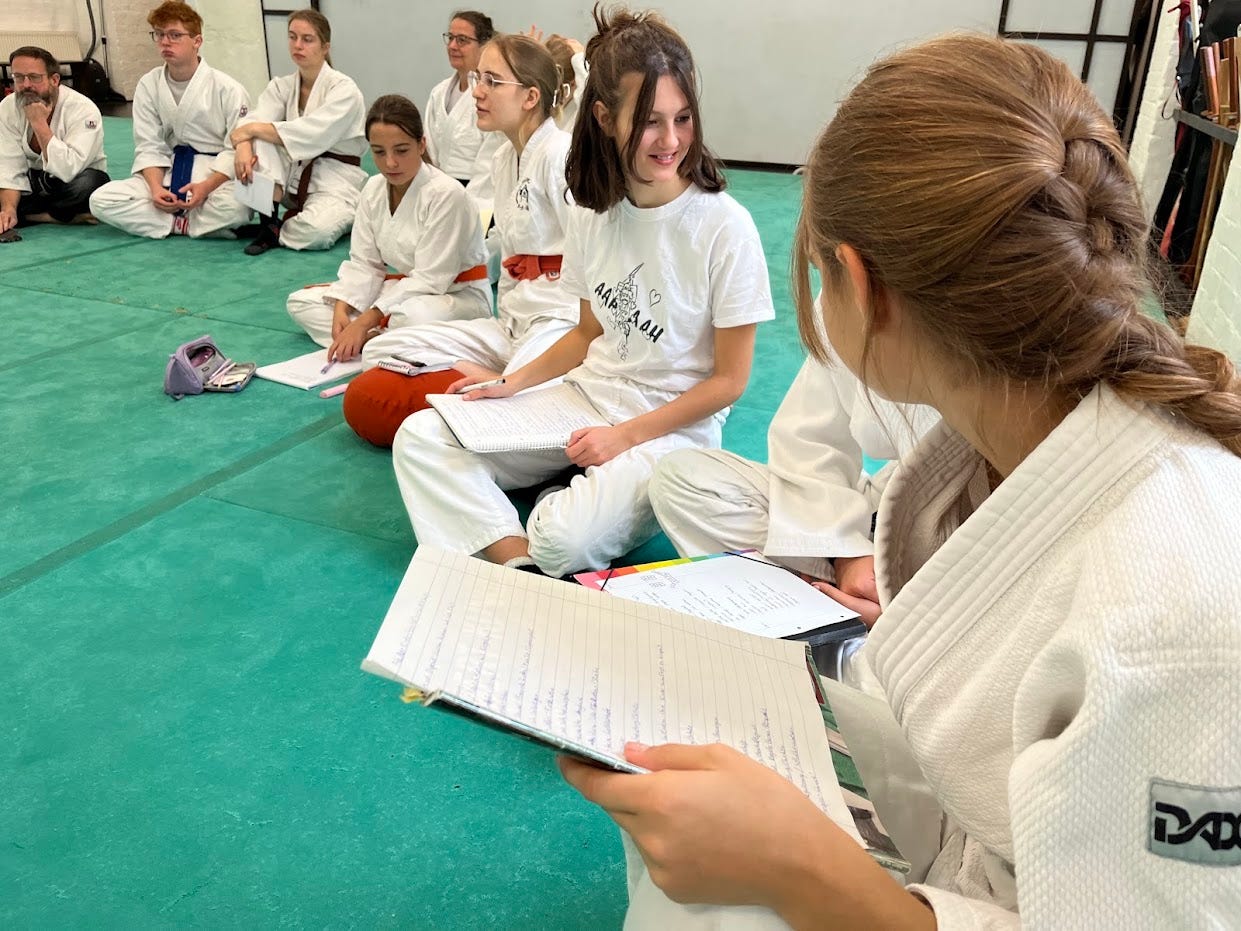Aikido with Teenagers: Growing up in the Dojo
A module in Aikido with Kids and Youth Training education program for Aikidoists, Senpai and Sensei
Hi there!
Last week, we shared with you the interview with Ilka Flora about the educational program for teachers called ‘Aikido for Kids and Youth Training’.
The following text describes my sample class for teenagers that was a part of the previous workshop of this program, as well as minutes from the following discussion.
The purpose of the class was to show other Aikido teachers what we do with teenagers in our dojo, how we do it, and why.
The text was written as a material for participating teachers and assistants and maybe you can benefit from it, too. Just read on.
The Sample Training for Teenagers
Class length: 1 hour 30 minutes
Circle
Introduction, setting the direction and purpose of the sample class, giving priority to teenagers.
Body / Mind Preparation
Warm-up - Goal: tuning in together
Some ukemi - Goal: a familiar activity to create the feeling of “we know all this”
Animals
Animals mirroring - in pairs from side to side of the dojo - one is showing and changing animals, and the other is mirroring them. Then they change roles. Goals: freedom, playfulness, performing, observing, analyzing, and reproducing movement…
“Flock” game - in groups of three, four, or everybody - all members of a group are the same animal until one of the group changes into another animal, then everybody in the group changes into that animal. When everybody changes into a new animal, again, someone can change the animal. The members of the group can move anywhere in the dojo. Goals: opening vision, cooperating, inducing or accepting a change…
Specific Martial / Movement Exercises
In this class, we used kicking as a tool for developing mobility and stability of the legs. By making the legs and feet aware, we improve Aikido footwork and also become more grounded in daily life.
In our dojo, we use movement themes like this to improve some aspects of Aikido / Martial practice in every teenage class. Usually, we set a topic and work with it for 1-2 months.
Kicking (conscious work with feet and legs)
“Walking” on the yoga blocks/bricks - each person has two bricks, stands on them and should move them with feet (ideally with different parts of feet) to get to the opposite side of the dojo. Goal: balance, shaping feet, standing on one leg while moving hip of the other leg (which is a basic movement for kicking).
Kin-geri practice (a simple kick)
Individually - to get the movement pattern
With a partner - walking and kicking from side to side
With a partner - one is offering a tennis ball as a target somewhere in the space, and the other one has to gently kick it. The position of the tennis ball should change (distance, direction, height) so that the kicking person must move their legs to find a proper place where to stand to kick the ball. Goals: Feeling of space and distance, free and appropriate footwork, playfulness…
Circle: a short discussion about why we kick. Goals: bringing the group together to share, showing that what we do has a purpose behind it, inducing analysis of what we do, opening mind to different interpretations, suggesting transmission between our practice and daily life (eg: If we have stable and conscious legs, we can "stand on one's own two feet" in our life, if we have balance in our practice, we can "have a firm footing" outside of the dojo, too.)
Aikido Techniques
Basic foot-work - individually changing hanmi on one line and at the 90-degree angle (irimitenkan)
Getting out of the grip with a partner - aihanmi katatedori, tori holds a tennis ball in their grabbed hand (palm up), moves legs in the 90-degree pattern (as in the previous exercise) and gets out of the grip by turning the hand around uke’s wrist, finishing with palm down. The other hand takes contact for kote-gaeshi. Goals: the tennis ball helps to keep the hand in a natural position and focuses awareness on full movement of the hand, until the wrist is free. The ball also helps to move the awareness from the gripped area to a free part of the body.
Group game: half of the group has a tennis ball. Everybody walks around the dojo. Any person without a ball can grab a wrist of anybody with a ball, the grabbed person should keep moving their legs while staying relaxed and get free by the movement from the previous exercise. Goals: perceiving the space, spontaneity and fluidity of the action, adaptation to different circumstances, staying relaxed when “surprised”, moving legs all the time, working with many partners (putting the group together)
Aihanmi katatedori kote gaeshi - practicing technique in the basic tori-uke relationship, after a while changing partners
The tennis balls can be used in different aikido techniques and attacks:
in gyakuhanmi katatedori tenkan (tori holds the ball, and it highlights hand movement)
in shomen uchi (uke holds the ball in striking hand, and the ball makes the trajectory of the cut more clear for tori)
…
Weapons (Swords)
Dodging cuts: In pairs. Person A is standing in shisen-tai, person B slowly and clearly cuts in different directions and distances, trying to reach different parts of the partner's body. Person A moves their body to avoid cuts while their legs stand in the same place. The avoidance should be slow, fluent and efficient (no extra movement), person A returns to shisen-tai after avoiding the cut. Person B can move around, delivering cuts from all directions. If person A fails to avoid the cut or loses balance, person B should repeat the same cut until person A finds a good solution.
Goals: movement of all body parts, economy of movement, perception in all directions, understanding distance, direction and time (both partners), feeling / reading the intention, mutual support, fun…Variations:
person A stands on the two yoga blocks (requires more awareness of balance)
groups of three: one person stands and two are cutting (one after the other)
Shin-Kokyu
Breathing exercise, to cool down and conclude the class.
Circle
Debriefing, evaluating the class, questions and comments… The teacher is available for students.
Discussion about Teenage Groups
Selected points
Partner Approach
In the circle at the beginning of the class, I asked teenagers if they agreed with adults practicing in their class. It was very important to establish the understanding that the class is for them, that they are the important group, and the adults and teachers are just visitors.
Otherwise, it would be just a mixed class, not a teenage class.
I use this attitude whenever I do something with teenagers: the class or any activity is ours, we’re together in it as partners, as equals. And I always side with them when necessary, trying to create a space where they feel safe and can be themselves.
There are 5 more sections of discussion in the following text:
Timing and Content of the Class
Let’s Move It!
Physical Development and Safety
Enabling Teenagers to Continue in Adult Classes
Further Reading about Aikido for Teenagers
If you want to read them, please consider becoming a paying subscriber.
If you’re interested in the next workshop, check the info in the previous article.
Keep reading with a 7-day free trial
Subscribe to Aikido: Art for Life to keep reading this post and get 7 days of free access to the full post archives.




